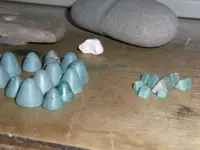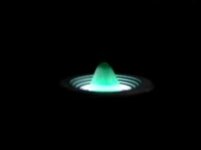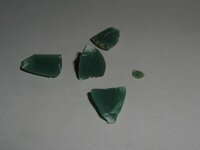O
Owise Owera
Guest
I?ve been hunting the same field for years and retrieved numerous items belonging to the inhabitants of this area, upstate N.Y. This time I thought about bringing along a metal detector to make a more thorough search for jewelry and colonial era coins. Sullivan campaigned right along this river, the Susquehanna. I detected the field for quite some time finding nothing. I noticed that the farmer added a few more feet to the edge of the cornfield and thought it a perfect opportunity to search before the other seekers from my area spotted it. These Green things caught my eye and the only explanation I got from a local historian is ?Oh those were dumped here by IBM back in the 40?s?. Okay, well, these were all that I found, clustered together in a two-foot area of soil about 50 yards from the riverbank. I personally can?t believe IBM would drive 30 miles to dump a handful of whatever these are in an open field. Any Ideas?














